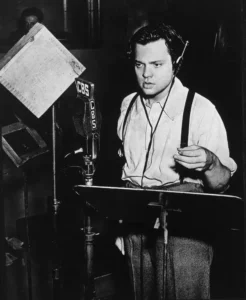The War of the Worlds (1938 Radio Broadcast)
This page is part of the True Adaptation Checklist project—a scene-by-scene analysis comparing various adaptations of H.G. Wells’ novel to the original. If you’re looking for a comprehensive overview of the 1938 broadcast, check out our article That Notorious Broadcast: Panic, Propaganda, and the Power of Radio for a deep dive into its cultural impact.
Director and Narrator: Orson Welles
Starring: Orson Welles (and The Mercury Theatre on the Air)
Unique Angle: A groundbreaking adaptation presented as a series of live news bulletins, supposedly creating widespread panic among listeners.
True Adaptation Checklist Evaluation
🔎 Curious how we decide what’s faithful?
See our True Adaptation Checklist — the foundation for every review.
Martian Invasion Essentials
🔽 Click to see how the invaders measure up
Cylinders (Martian Landing Pods)
✅ Yes
The Martians’ arrival is clearly portrayed as cylinders crashing to Earth, matching the book’s detail.
Tripods
✅ Yes
The Martian machines are described as “tripods” in the broadcast, consistent with the book.
Tentacles
✅ Yes
The Martians are described as tentacled creatures, staying true to the original.
Red Weed
❌ No
No mention or depiction of the red weed.
Black Smoke
✅ Yes
The Martians deploy a black smoke-like weapon, aligning with the book.
Heat Ray
✅ Yes
The heat ray is described in the broadcast and plays a key role in the destruction.
Snatching and Feeding on Humans
⚠️ Sort of
The narrator states, “I’ve seen them feed,” but no details are provided on how or on what. Human consumption is not confirmed.
Martians Destroyed by Microorganisms
✅ Yes
The Martians are defeated by Earth’s microorganisms, as in the original.
Martian Intelligence
✅ Yes
The broadcast presents the Martians as technologically advanced and methodically destructive.
Essential Characters
🎭 Click to view character comparisons
The Narrator
✅ Yes
Orson Welles plays the central voice guiding listeners through the events.
The Curate
❌ No
No character resembling the Curate is present.
The Artilleryman
✅ Yes
A military survivor delivers a monologue closely resembling the Artilleryman’s worldview and plan from the book.
The Astronomer (e.g., Ogilvy)
✅ Yes
Professor Pierson plays a major role both as the astronomer and later as the narrator himself.
The Brother (Secondary Perspective)
❌ No
The story does not shift to a secondary narrative perspective.
The Wife (Emotional Anchor)
⚠️ Sort of
The narrator expresses concern for his wife, but this is not developed.
Atmosphere and Allegory
🧠 Click for thematic breakdown
Appropriate Era & Setting
✅ Yes
Though the Victorian England setting is updated to 1938 America, the shift retains the novel’s core themes, including technological vulnerability and societal collapse.
Societal Collapse
✅ Yes
The broadcast effectively depicts widespread panic, confusion, and social breakdown.
No Human Victory
✅ Yes
Humanity doesn’t defeat the Martians—they die from microorganisms, preserving the original.
Atmosphere of Horror and Helplessness
✅ Yes
The radio format builds a chilling sense of real-time dread and helplessness.
Narrator’s Psychological Decline
⚠️ Sort of
Some emotional fatigue is conveyed, but not explored in depth.
Cinematic & Immersive Details
🎥 Click to explore cinematic elements
Martian Sounds
✅ Yes
Disturbing alien and mechanical sounds are used to convey Martian presence.
Visuals of Red Weed and Black Smoke
⚠️ Sort of
Black smoke is described; red weed is completely absent.
Heat Ray Effects
✅ Yes
The sound design effectively simulates the destruction caused by the ray.
Desolate Landscapes
⚠️ Sort of
Destruction is implied through audio; no visuals due to the medium.
Decay and Rot
❌ No
There are no references to decomposition or the post-invasion aftermath.
Bonus Features
⭐ Click for bonus adaptation features
The Thunder Child (Naval Resistance)
✅ Yes
A military last stand is portrayed when aircraft launch an attack on the tripods—mirroring the spirit of the Thunder Child.
Adaptation-Specific Creativity
✅ Yes
The news bulletin format redefined audio storytelling and commentary on media, fear, and public trust.
Observations and Analysis
🧩 Click to view strengths, weaknesses, and creative twists
Strengths:
- Innovative radio format created unparalleled immersion and tension.
- Retains many core elements of the invasion (Martians, heat ray, black smoke, and microbial defeat).
- A brilliant commentary on mass media, trust, and panic.
Weaknesses:
- Omits major characters like the Curate and Brother.
- Limited by its format in showing visual elements like tripods or landscapes.
- Original content heavily edited to fit hour-long broadcast window
Creative Deviations:
- Updates the story to 1938 America and tells it in real-time via news bulletins.
- Functions as both a sci-fi story and media satire, blending fiction and social commentary.
Haven’t read the book?
📖 No problem — here’s a full chapter-by-chapter breakdown.
Faithfulness Rating
Mostly Faithful
📏 Why did we rate it this way? Click to reveal.
Though modernized in format and setting, the 1938 radio broadcast remains remarkably true to the spirit and core substance of H.G. Wells’ novel. It preserves key plot points, central themes, and tone—capturing the horror, societal collapse, and microbial resolution that define the original work.
Our Verdict
💭 Here’s what we really think — click to reveal our verdict.
Orson Welles’ 1938 War of the Worlds radio drama is a cultural lightning rod and a triumph of creative adaptation. Though it diverges from the novel in several ways, its realism, originality, and psychological power make it one of the most iconic interpretations of Wells’ alien invasion tale. Two very enthusiastic thumbs up.
🧠 Decide for Yourself
Want to form your own opinion?
Check out the broadcast here.
Curious how other adaptations stack up to our True Adaptations Checklist? Check out these popular adaptations below:

